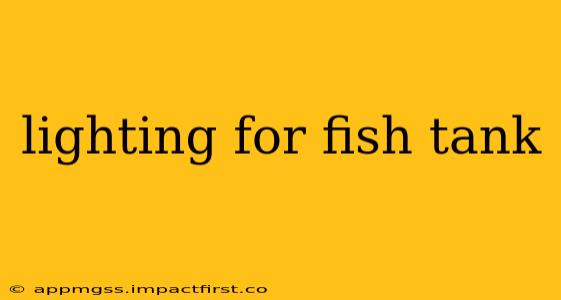Choosing the right lighting for your fish tank is crucial for the health and happiness of your aquatic inhabitants. It's not just about aesthetics; proper lighting supports plant growth, influences fish behavior, and even helps prevent algae blooms. This comprehensive guide will delve into the various aspects of fish tank lighting, answering your burning questions and ensuring your underwater world thrives.
What Kind of Lighting Do Fish Need?
This depends heavily on the inhabitants of your tank. Fish originating from different environments have adapted to varying light intensities and spectrums. For example, brightly-colored fish from shallow reefs often prefer higher light levels than those residing in deeper, darker waters. Similarly, planted tanks demand significantly more intense lighting than tanks with only fish. Consider the specific needs of your fish and plants when making your selection. Researching the natural habitat of your species is key to providing the appropriate lighting.
How Many Hours of Light Do Fish Need?
The ideal lighting duration varies depending on the species and whether you have live plants. Generally, a photoperiod (daily light cycle) of 8-10 hours is a good starting point for most community tanks. However, some fish may prefer longer or shorter periods. Plants, on the other hand, often benefit from longer light cycles, up to 12 hours a day, depending on the species. Too much light can lead to algae overgrowth, while too little can stunt plant growth and weaken your fish. Observe your tank and adjust accordingly.
What is the Best Type of Light for a Fish Tank?
Several options exist, each with its advantages and disadvantages:
-
Fluorescent Lights: These are a classic choice, offering good light output for the price. They are energy-efficient and relatively long-lasting. However, they can be less aesthetically pleasing than other options and their color rendering might not be as vibrant.
-
LED Lights: LED lights are rapidly becoming the industry standard due to their energy efficiency, long lifespan, customizable color temperatures and spectrums, and compact size. They're also excellent for creating specific light intensities needed for planted tanks.
-
Metal Halide Lights: These produce very bright, high-intensity light, often favored by reef tank enthusiasts to mimic natural sunlight. However, they consume significantly more energy and generate more heat than other options.
-
T5 Fluorescent Lights: These offer higher intensity and better color rendition than standard fluorescent tubes, making them a suitable option for planted tanks. They're still relatively energy-efficient, but their lifespan is shorter than LEDs.
How Much Light Does a Planted Tank Need?
Planted tanks require significantly more light than those without plants. The specific light requirements vary greatly depending on the plant species. High-light plants need intense, long-duration lighting, while low-light plants can thrive with less intense, shorter periods of light. Consider researching the light needs of your specific plant species and choose lighting accordingly. Supplementing with CO2 injection may also be necessary for vigorous plant growth under high-light conditions.
How Do I Prevent Algae in My Fish Tank with Proper Lighting?
Algae is a common problem in fish tanks, often linked to excessive lighting. Preventing algae involves:
- Appropriate Lighting Duration: Avoid excessively long photoperiods.
- Proper Light Intensity: Match lighting intensity to the needs of your plants and fish.
- Regular Maintenance: Perform regular water changes and clean the tank's glass to remove accumulated algae.
- Balanced Nutrition: Avoid overfeeding, as uneaten food contributes to nutrient build-up that fuels algae growth.
Properly managing lighting, along with maintaining good water quality and a balanced ecosystem, is crucial in preventing problematic algae growth.
What is PAR in Fish Tank Lighting?
PAR, or Photosynthetically Active Radiation, measures the amount of light available for photosynthesis in your tank. It's a crucial factor for planted tanks, indicating how effectively your plants will grow under your chosen lighting system. Higher PAR values generally mean more light is available for plant growth, but it's vital to select a PAR level appropriate for your chosen plant species to avoid problems like algae blooms.
Remember, choosing the right lighting for your fish tank is a balancing act. Consider your fish and plant species, their specific needs, and the overall environment you want to create. With careful planning and observation, you can ensure your aquatic friends thrive under optimal lighting conditions.
